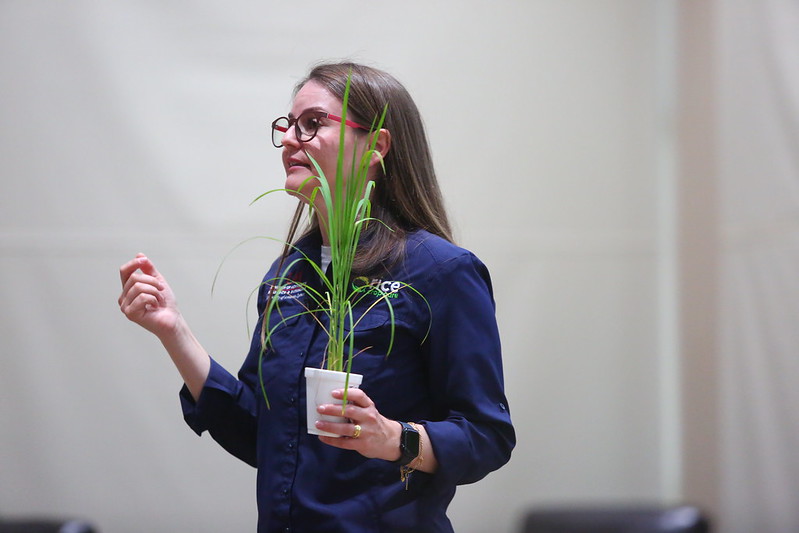Rice disease training bolsters identification and control techniques for growers, consultants
July 19, 2024
By Ryan McGeeney
U of A System Division of Agriculture
Fast Facts:
- July 9 workshop focused on disease I.D. in rice
- Featured lecturers from U of A, USDA and Louisiana State University
(262 words)
(Newsrooms: Download photos from the workshop)
STUTTGART, Ark. — More than 40 growers, consultants and other agriculture industry professionals received in-depth training on identifying and controlling various diseases commonly found in rice last week at the University of Arkansas System Division of Agriculture's Rice Research and Extension Center.
With between 1.2 million and 1.5 million acres of rice planted in the state each year, Arkansas provides about half of the United States’ rice production. Knowing how to identify and control common pests and diseases is key to protecting and maximizing that investment.
Camila Nicolli, extension plant pathologist and assistant professor for the Division of Agriculture, organized the July 9 Rice Disease Training workshop. In addition to multiple speakers and slideshow demonstrations, Nicolli provided numerous samples of potted rice plants, affected with various diseases, for attendees to examine up close.
“Disease identification can be determined by shape and coloration of the lesions,” Nicolli said. “But control is a combination of information that will give you the best management — identifying the right disease, host resistance and the right fungicide product.”
Presenters included Nicolli, as well as Terry Spurlock, extension pathologist for the Division of Agriculture; Rodrigo Pedrozo, USDA plant pathologist at the Dale Bumpers National Rice Research Center; and Felipe Dalla Lana da Silva, Louisiana State University state rice pathologist.
Nicolli said many attendees expressed interest in learning to identify some of the trickier diseases affecting rice in Arkansas.
“They were very interested in identifying early blast symptoms and narrow brown leaf spot in rice,” Nicolli said. “This last one in particular because it is more difficult to identify.”
To learn about extension programs in Arkansas, contact your local Cooperative Extension Service agent or visit www.uaex.uada.edu. Follow us on X and Instagram at @AR_Extension. To learn more about Division of Agriculture research, visit the Arkansas Agricultural Experiment Station website: https://aaes.uada.edu/. Follow on X at @ArkAgResearch. To learn more about the Division of Agriculture, visit https://uada.edu/. Follow us on X at @AgInArk.
About the Division of Agriculture
The University of Arkansas System Division of Agriculture’s mission is to strengthen agriculture, communities, and families by connecting trusted research to the adoption of best practices. Through the Agricultural Experiment Station and the Cooperative Extension Service, the Division of Agriculture conducts research and extension work within the nation’s historic land grant education system.
The Division of Agriculture is one of 20 entities within the University of Arkansas System. It has offices in all 75 counties in Arkansas and faculty on five system campuses.
Pursuant to 7 CFR § 15.3, the University of Arkansas System Division of Agriculture offers all its Extension and Research programs and services (including employment) without regard to race, color, sex, national origin, religion, age, disability, marital or veteran status, genetic information, sexual preference, pregnancy or any other legally protected status, and is an equal opportunity institution.
# # #
Media Contact:
Ryan McGeeney
rmcgeeney@uada.edu
@Ryan_McG44
501-671-2120
